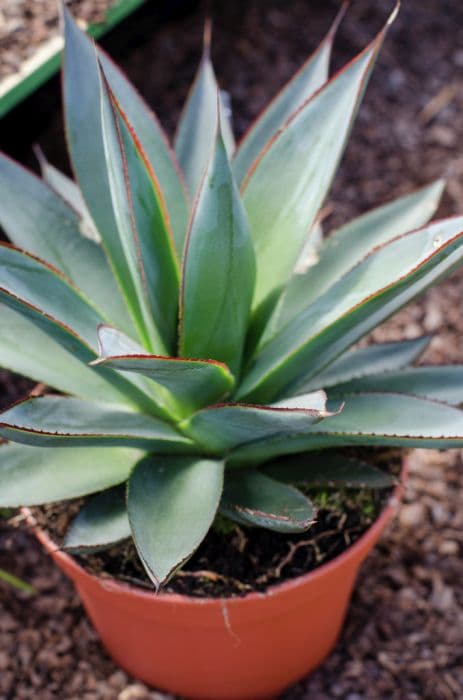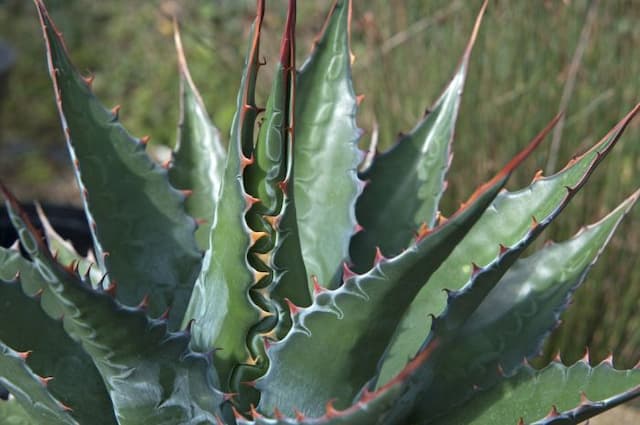Hawaiian Ti Plant Cordyline 'Pink Stripe' (v)

ABOUT
Cordyline 'Pink Stripe', also widely known as Ti plant, is an ornamental garden plant famed for its striking foliage. Its appearance comprises bold, upright leaves that create a fountain-like effect. The leaves themselves are elongated and sword-like with a smooth and leathery texture. The Ti plant boasts a mesmerizing color palette, with leaves featuring a blend of vibrant green and creamy colors. Predominantly, a deep green forms the base of the foliage. The most captivating characteristic, however, is the vivid pink stripes that run along the length of each leaf, contrasting sharply against the green and adding to the plant's tropical appearance. The edges of the leaves are often outlined with a thin line of the same pink hue, accentuating their elongated shape and adding an extra pop of color. The overall impression of Cordyline 'Pink Stripe' is that of a lush and exotic plant that can add a splash of color and visual interest to any environment where it is displayed.
About this plant
 Names
NamesFamily
Asparagaceae
Synonyms
Hawaiian Ti Plant, Good Luck Plant, Ti Plant, Cordyline Fruticosa 'Pink Stripe'
Common names
Cordyline 'Pink Stripe' (v).
 Toxicity
ToxicityTo humans
The Cordyline, commonly referred to as the Ti Plant, is not considered highly toxic to humans. However, ingesting parts of the plant might cause mild symptoms, such as irritation in the mouth, throat, or stomach. In rare cases, more severe symptoms like nausea, vomiting, or diarrhea could occur. It's advisable to keep this decorative plant out of the reach of children, who might be tempted to chew on its leaves.
To pets
The Ti Plant is recognized as toxic to pets, including dogs and cats. If a pet ingests any part of the plant, they could experience symptoms like vomiting, increased salivation, reduced appetite, or depression. Cats may also suffer from dilated pupils. If you suspect your pet has ingested part of this plant, it's important to contact your veterinarian promptly.
 Characteristics
CharacteristicsLife cycle
Perennials
Foliage type
Evergreen
Color of leaves
Variegated
Height
3-4 feet (0.9-1.2 meters)
Spread
2-3 feet (0.6-0.9 meters)
Plant type
Shrub
Hardiness zones
9
Native area
Pacific
Benefits
 General Benefits
General Benefits- Visual Appeal: With its striking pink-striped foliage, the Ti plant adds a vibrant splash of color to any garden or indoor space.
- Low Maintenance: It is relatively easy to care for, requiring minimal pruning and tolerating a range of light conditions.
- Versatility: It can be grown outdoors in warm climates or indoors as a houseplant in cooler areas.
- Improves Landscaping: Adds texture and an exotic touch to landscaping designs.
- Container Gardening: Suitable for pots and containers, making it ideal for balconies and patios.
 Medical Properties
Medical PropertiesThis plant is not used for medical purposes.
 Air-purifying Qualities
Air-purifying QualitiesThis plant is not specifically known for air purifying qualities.
 Other Uses
Other Uses- Craft projects: The long, colorful leaves of the Ti plant can be used for weaving baskets, hats, and other traditional crafts due to their flexibility and strength.
- Themed garden designs: Ti plant can be a key element in creating themed gardens such as a 'pink paradise' due to its vibrant pink-striped leaves.
- Culinary garnish: Although not commonly consumed, the Ti plant leaves can be used as a natural and ornamental garnish for plating in high-end culinary presentations.
- Natural dye: The colorful leaves, especially when dried, may be used to extract natural dyes for fabric or craft projects.
- Privacy screens: When planted in a row, Ti plants can serve as a privacy screen for patios and decks with their dense foliage.
- Aquascaping: For large aquariums, the hardy leaves of the Ti plant can be incorporated into aquascaping designs, as long as they are kept above the waterline.
- Photography backdrops: The striking leaves of the Ti plant can be used as a unique and vibrant backdrop for product or portrait photography sessions.
- Floral arrangements: Ti plant leaves can be included in floral arrangements for their striking color contrast and tropical feel.
- Educational purposes: The plant can be used in educational settings to teach about plant diversity, tropical ecosystems, or as a visual aid in art and design classes.
Interesting Facts
 Feng Shui
Feng ShuiThe Cordyline plant, commonly known as Ti plant, is believed to bring good fortune and is often used in Feng Shui. It's recommended to place the Ti plant in the wealth area of your home or business to attract positive energy and prosperity. Its vibrant pink stripes can add a splash of color and enhance the visual appeal of the space, helping to balance the five elements, specifically nourishing the wood element with its foliage.
 Zodiac Sign Compitability
Zodiac Sign CompitabilityThe Ti plant is not used in astrology practice.
 Plant Symbolism
Plant Symbolism- Longevity: Cordylines are known for their hardiness and longevity, symbolizing an enduring nature and the ability to withstand challenges over time.
- Tropical Beauty: The 'Pink Stripe' variety, with its vibrant pink accents, often represents exotic beauty and a sense of escape to tropical destinations where such plants are commonly found.
- Wealth and Prosperity: In some cultures, particularly in Asia, cordylines are considered to bring good luck and are associated with wealth and prosperity when planted around homes.
- Healing and Protection: Certain traditions hold that Cordyline plants have healing properties and can protect against negative energies, symbolizing safety and restoration.
 Water
WaterThe Ti plant prefers consistent moisture, so it’s vital to water it when the top inch of soil feels dry to the touch. Generally, this means watering approximately once a week, but this frequency can vary based on light and humidity conditions. When watering, use room temperature water and slowly pour it around the base of the plant until it begins to drain from the bottom of the pot, which could take around one to two gallons for a medium-sized plant every month. Always allow excess water to drain to prevent root rot. During the winter, reduce watering slightly as the plant's growth slows down.
 Light
LightThe Ti plant thrives in bright, indirect light but can tolerate some direct sunlight. A spot that receives filtered sunlight, such as behind a sheer curtain, is ideal. Avoid harsh afternoon sun, which can scorch the leaves, and also avoid deep shade, as this can lead to a loss of leaf color and vitality. Rotate the plant periodically to ensure even light exposure on all sides.
 Temperature
TemperatureThe Ti plant prefers warm temperatures between 65 and 85 degrees Fahrenheit but can survive in a range slightly outside of this if necessary. It is not frost-hardy, and exposure to temperatures below 50 degrees Fahrenheit can be detrimental to its health. The ideal temperature range should be maintained year-round for optimal growth.
 Pruning
PruningPruning the Ti plant promotes bushier growth and is best done in the spring or early summer. Cut back any leggy stems, dead leaves, or spent flowers to encourage a fuller plant. Prune sparingly, as over-pruning can stress the plant. Regularly remove any yellowing or brown leaves to maintain the plant's appearance and health.
 Cleaning
CleaningAs needed
 Soil
SoilTi plant thrives in a well-draining, rich potting mix with a pH of 6.0 to 6.5. A mix of two parts peat moss or coco coir, one part perlite, and one part pine bark is ideal, promoting good drainage and aeration while retaining enough moisture.
 Repotting
RepottingTi plant should be repotted every 2-3 years or when roots become crowded. Choose a pot only slightly larger than the current one to prevent overwatering issues.
 Humidity & Misting
Humidity & MistingTi plant prefers high humidity levels, ideally between 40-60%. Maintain high humidity around the plant using a humidifier or a pebble tray with water.
 Suitable locations
Suitable locationsIndoor
Place Ti plant in bright, indirect light and keep away from drafts.
Outdoor
Plant Ti plant in partial shade; shelter from strong winds.
Hardiness zone
10-12 USDA.
 Life cycle
Life cycleCordyline 'Pink Stripe', commonly known as Pink Stripe Dracaena, begins its life as a seed, germinating in warm, moist soil conditions and developing its first root and shoot. As it enters the seedling stage, it develops a set of true leaves that begin photosynthesis. The plant transitions to the vegetative stage, where it grows actively, developing a strong stem and a rosette of pink-striped, lance-shaped leaves. In maturity, after several years, it may produce fragrant flowers in clusters, which if pollinated, result in berry-like fruits containing seeds. The plant can live for many years, with some individuals capable of reaching over a decade in optimal conditions. Over time, the lower leaves may wither and drop, encouraging the growth of new foliage from the top; eventually, an old plant may decline in vigor, completing its life cycle.
 Propogation
PropogationPropogation time
Spring-Early Summer
Propogation: The Cordyline 'Pink Stripe', commonly known as the "Ti plant," is often propagated through stem cuttings. The optimal time to take these cuttings is during the warm growing season, which typically extends from late spring to early summer. To propagate the Ti plant, choose a healthy, mature stem and cut a segment roughly 3 to 5 inches (about 8 to 13 cm) long, ensuring there are several leaf nodes present. Strip the lower leaves and place the cutting either in water or directly into a pot filled with a light, well-draining potting mix. Keep the soil moist but not waterlogged, and place the pot in a warm area with bright, indirect light. Roots will usually develop within a few weeks, and once they are well-established, the new plant can be transplanted if necessary.









